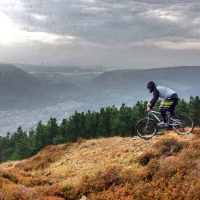Roof advice wanted, please

By that I mean that
1. The slates lap directly onto the bricks, there's no edging of any type, no overhang.
2. It's a mess.
I want to know what that type of edge is called if there is a name for it, or even, what do you call the 'bit where the roof meets the wall'?
And is it possible to get some sort of cover for it? I've seen a sort of plastic angled thing that goes over tiles but not one for slates. I've got a scaffolding tower and I'm capable of pointing it, just wondered if there were other options.
Ta.
The older I get, the better I was.
Comments
-
I'm not a roofer, but have worked on roofs. The gable end where the roof meets is called a verge. You can get dry verge systems for slate, but I don't know if you can retrofit them without removing slates. Not having an overhang might be a problem.
Maybe using traditional mortar would be an easier option (and cheaper). A temporary wooden batten on the wall and a bead of mortar (use sharp sand) would neaten it up.
I'm sure there must be a roofer on here.0 -
It's called a skew up here.
Where the fcuk is that supposed to drain to? Is it literally just flat from the gable end?0 -
You might find the batten ends have rotted back.0
-
Not everywhere is as wet as Scotland.First.Aspect said:It's called a skew up here.
Where the fcuk is that supposed to drain to? Is it literally just flat from the gable end?1985 Mercian King of Mercia - work in progress (Hah! Who am I kidding?)
Pinnacle Monzonite
Part of the anti-growth coalition0 -
It's almost as dry here as London. The wind is the issue. This means we often don't have overhangs. But by the same token if the wind hits that roof at an angle, it will just cause water to dribble off the slates and down the gable end won't it?rjsterry said:
Not everywhere is as wet as Scotland.First.Aspect said:It's called a skew up here.
Where the fcuk is that supposed to drain to? Is it literally just flat from the gable end?
Edit - I'm in the east, in the rain shadow of the southern uplands (mountains as nice as the Pennines that you haven't heard of and that I don't want you to visit, fcuk off) so we get about 7-800 mm a year on average. London gets nearly 700, on average.0 -
As above, you would probably be best with a dry-verge system. Have a look at the Marley or Klober range of products. They do individual plastic covers that interlock with each other to provide a continuous length, or you can also buy it in longer lengths to fit as one piece. Something like this perhaps?
https://www.roofingsuperstore.co.uk/product/dv9-dry-fix-continuous-grp-face-fix-dry-verge-for-scottish-slate-3m.html
It is a DIY job if you are ok with heights and have scaffolding, do not do it off a ladder. The products are very slate/tile specific so worth taking time to research exactly what you need. The plastic cover(s) essentially fix on to the wooden battens that your slates are nailed to. It's a bit fiddly but easy enough - sturdy access is the key and a DIYers knowledge and handling of tools.
You could redo the mortar, I suppose, but you'd probably end up redoing it quite frequently. Dry system is pretty much maintenance free.Bianchi ImpulsoBMC Teammachine SLR02 01Trek Domane AL3“When I see an adult on a bicycle, I do not despair for the future of the human race. “ ~H.G. Wells Edit - "Unless it's a BMX"0 -
The walls get wet when it rains anyway. Unless there is no wind at all and it just drops straight down. A 9" brick wall will keep a lot out and a mortared verge like that is fairly common.First.Aspect said:
It's almost as dry here as London. The wind is the issue. This means we often don't have overhangs. But by the same token if the wind hits that roof at an angle, it will just cause water to dribble off the slates and down the gable end won't it?rjsterry said:
Not everywhere is as wet as Scotland.First.Aspect said:It's called a skew up here.
Where the fcuk is that supposed to drain to? Is it literally just flat from the gable end?
Edit - I'm in the east, in the rain shadow of the southern uplands (mountains as nice as the Pennines that you haven't heard of and that I don't want you to visit, fcuk off) so we get about 7-800 mm a year on average. London gets nearly 700, on average.1985 Mercian King of Mercia - work in progress (Hah! Who am I kidding?)
Pinnacle Monzonite
Part of the anti-growth coalition0 -
It drains down the slope of the roof, although there's nothing to stop it going sideways, there's nothing to encourage it either.First.Aspect said:It's called a skew up here.
Where the fcuk is that supposed to drain to? Is it literally just flat from the gable end?
The house was built in 1911, so it hasn't done too badly, but I suppose it has been pointed before when the brickwork was done.
I'm not too bad with heights, as long as I feel safe, hence the scaffold tower.
The older I get, the better I was.0 -
What's stopping water getting under the slates if the wind is hitting the gable end?0
-
It's not really any different in that respect to my tiled roof with soffit and fascia boards. Mine relies on mortar fillets under the tiles (some of which have fallen out in recent years narrowly missing the car on the drive!).First.Aspect said:What's stopping water getting under the slates if the wind is hitting the gable end?
0 -
The Sparrows nestsFirst.Aspect said:What's stopping water getting under the slates if the wind is hitting the gable end?

0 -
Mortar joint.First.Aspect said:What's stopping water getting under the slates if the wind is hitting the gable end?
It's not a brilliant design, but it's not something you look at really is it? "oh, it's got the right number of bedrooms, a great location and massive garden, but just look at the way the slates join the gable end"
Actually, the buying process didn't go anything like that.
I'm living in the house i was born in, literally, I was born in the bedroom where I now sleep each night. I moved out when I was around 20, to MY first house, later got married and then moved to another place. When my dad died, it got too much for my mum, and so we bought it off her and she moved to a bungalow.
It has a lot of memories. If I take old paper off the walls, i find things underneath that I drew as a kid. I upgraded a radiator, and the marks for the fixings behind the old one are the those i made when I hung it at about 13.
The older I get, the better I was.4 -
God. I think I'd end up in secured mental accommodation if I ended up back where I grew up.
House purchases tend to be heart over head. Ours was.
We have a highly flawed roof that turned out to put the tiles lower than the gully next to the skews and sealed with mortar. So had the tendency to funnel water under the mortar and down the inside wall, rather than a faster drainage route down a gulley.
We now have a lot of lead to seal it.
Don't talk to me about the electrics.0 -
It was only in 2005 that electrical installations came under the building regs. After an MP's daughter died in a fire caused by faulty wiring. Which is mad when you think about it.1985 Mercian King of Mercia - work in progress (Hah! Who am I kidding?)
Pinnacle Monzonite
Part of the anti-growth coalition0 -
Ours were done by a blacksmith.rjsterry said:It was only in 2005 that electrical installations came under the building regs. After an MP's daughter died in a fire caused by faulty wiring. Which is mad when you think about it.
He put about 5 loops of fuse wire around the oven fuse. You could have run hs2 through it. And then there was the extesion plug inside the wall, in the bathroom, under the leaking pipes. And the live nail in the skirting board.
The garden wiring was much worse though.0 -
It's so common. We got an electrician to inspect our house when we bought it and he insisted we shouldn't move in until he rewired from scratch. The whole house was running through a single fuse including an electric shower that was clearly leaking.First.Aspect said:
Ours were done by a blacksmith.rjsterry said:It was only in 2005 that electrical installations came under the building regs. After an MP's daughter died in a fire caused by faulty wiring. Which is mad when you think about it.
He put about 5 loops of fuse wire around the oven fuse. You could have run hs2 through it. And then there was the extesion plug inside the wall, in the bathroom, under the leaking pipes. And the live nail in the skirting board.
The garden wiring was much worse though.1985 Mercian King of Mercia - work in progress (Hah! Who am I kidding?)
Pinnacle Monzonite
Part of the anti-growth coalition0 -
ha ha , yep similar here. Rubber insulated cable feeding a junction box buried in the plaster at a random height. Individual cotton insulated conductors in metal conduit from the 1920's, all sorts. rewired the house myself, it really isn't that difficult.rjsterry said:
It's so common. We got an electrician to inspect our house when we bought it and he insisted we shouldn't move in until he rewired from scratch. The whole house was running through a single fuse including an electric shower that was clearly leaking.First.Aspect said:
Ours were done by a blacksmith.rjsterry said:It was only in 2005 that electrical installations came under the building regs. After an MP's daughter died in a fire caused by faulty wiring. Which is mad when you think about it.
He put about 5 loops of fuse wire around the oven fuse. You could have run hs2 through it. And then there was the extesion plug inside the wall, in the bathroom, under the leaking pipes. And the live nail in the skirting board.
The garden wiring was much worse though.
You wont catch me on the roof though....
Yes dry-verge. or no-more-nails to hold a length of UPVC angle onto it. REally the edge should be slightly raised compared with the rest of tiled surface to encourage the run off down the roof rather than off of the edge. I'll wager the the wood is rotten on the so lifted the tiles off of the mortar joint.0 -
rjsterry said:
It was only in 2005 that electrical installations came under the building regs. After an MP's daughter died in a fire caused by faulty wiring. Which is mad when you think about it.
True story. The daughter was a lifelong friend of my wife's. Except it was a badly wired dishwasher, that had just been installed by a kitchen company and she was electrocuted by it.
(I'm not arguing about what exactly was changed, but know it was to put a stop to anybody doing it who wasn't qualified).0 -
Thanks. Faulty memory on my part.1985 Mercian King of Mercia - work in progress (Hah! Who am I kidding?)
Pinnacle Monzonite
Part of the anti-growth coalition1 -
What always surprises me is that a lot of bad wiring is sausage fingered can't be bothered wiring. I mean trapping a bit of copper wire under a grub screw isn't hard. And yet it seems to be.0
-
Are things safer nowadays with RCDs, rather than fuses? They seem to work well (trip) when you get a faulty electrical device- like a kettle about to go up in smoke.0
-
What's wrong with removing about an inch of insulation and cramming it in the plug. Surely that's no worse than removing 3 inches of the housing and leaving the inner cables dangling out and not clamped?oxoman said:The normal censored ups are incorrect cable sizes. No earth sleeving causing potential short circuits. Incorrect routing of cables or protection both electrical and mechanical.
In my experience both of these are perfectly acceptable ways to wire a plug or a light fitting or a wall socket.
Not even sure things need to be earthed these days.0 -
My dad used to use some of his tools in his garage without plugs. He just used an electricians screwdriver and shoved the bare wires into the sockets. He never had much respect for 240v mains.0
-
Just a wee tingle if you get something wrong.masjer said:My dad used to use some of his tools in his garage without plugs. He just used an electricians screwdriver and shoved the bare wires into the sockets. He never had much respect for 240v mains.
I tried to wire up a washing machine motor that way once.
I'm okay now.0 -
His term was "ooh, I got a poke from that".1
-
My grandad showed me how to use matchsticks to push in the live conductors when I was about 10 years old. Spent many a happy hour stripping the back off my “portable” crt tv.First.Aspect said:
Just a wee tingle if you get something wrong.masjer said:My dad used to use some of his tools in his garage without plugs. He just used an electricians screwdriver and shoved the bare wires into the sockets. He never had much respect for 240v mains.
I tried to wire up a washing machine motor that way once.
I'm okay now.
I have no idea how I actually survived being young and clueless.0 -
My dad was similar, except that it was the 5A lighting circuit.masjer said:My dad used to use some of his tools in his garage without plugs. He just used an electricians screwdriver and shoved the bare wires into the sockets. He never had much respect for 240v mains.
I can recall visiting once and he showed me the state of the wires for the lights, under the upstairs floor boards. I think they must have been the original*, and as he picked them up, the insulation was shedding off them. These were still live. I told him to stop, his reply was something along the lines of "It's only 5A".
* (after the gas lighting was replaced! I removed one of those pipes a couple of years ago)
The older I get, the better I was.1 -
Probably working under the "volts jolt, current kills" :-)capt_slog said:
My dad was similar, except that it was the 5A lighting circuit.masjer said:My dad used to use some of his tools in his garage without plugs. He just used an electricians screwdriver and shoved the bare wires into the sockets. He never had much respect for 240v mains.
I can recall visiting once and he showed me the state of the wires for the lights, under the upstairs floor boards. I think they must have been the original*, and as he picked them up, the insulation was shedding off them. These were still live. I told him to stop, his reply was something along the lines of "It's only 5A".
* (after the gas lighting was replaced! I removed one of those pipes a couple of years ago)0






